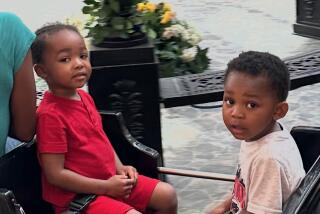One Twin Dies After Surgery for Separation
- Share via
SAN DIEGO — In a day that began with hope, soared to elation and then ended with shock and sorrow, a surgical team Saturday successfully separated 15-day-old Siamese twins, only to have the weaker twin die of cardiac arrest just an hour after the delicate five-hour operation.
Throughout the day, doctors at Children’s Hospital had issued increasingly optimistic bulletins that both Sarah and Sarahi Morales had a good chance to survive the rarely performed operation.
Word was passed that surgeons were buoyed that Sarahi’s malformed heart was stronger than had been expected and that the liver separation, one of medicine’s most difficult operations, had gone splendidly.
The twins, born to an automobile mechanic and his wife from Tijuana, were joined at the abdomen, chest and liver. They had separate hearts connected by three arteries.
“What happened to Sarahi was exactly what we had feared--that she was not strong enough to live by herself,” said Dr. John Lamberti, director of the hospital’s cardiac institute. “We thought she had a chance and we felt we owed it to her to give her that chance.”
Sarah is considered healthy with excellent chances for a normal life, doctors said.
*
The babies had been taken from the operating room about 4 p.m. to the intensive care unit. At 4:30 p.m., nurses and other technicians, most with wide smiles and some with their eyes glistening with tears of relief, told reporters of their joy that both babies had survived.
They described an operation that had gone much quicker and with fewer complications than anticipated and admitted that before the procedure, they had feared deeply that Sarahi would not survive the separation.
“We were all very excited when we saw how well Baby B [Sarahi] had done,” said registered nurse Joan Sendrowski.
Nurse Kellie Inveiss said: “We were all very emotional and fighting tears.”
The first indication that something had gone wrong came when a 5 p.m. news conference scheduled by the doctors was delayed without explanation.
Fifteen minutes later, somber-faced doctors, backed by the nurses and others from the 30-member surgical team, filed into a medical conference room to break the bittersweet news that Sarah was fine but Sarahi was dead.
“There is no victory without defeat,” announced Dr. Michael Segall, director of neonatology.
Lamberti said that Sarahi had gone into cardiac arrest at 4:45 p.m. and, despite vigorous attempts at resuscitation by a team of doctors, was pronounced dead at 5:05 p.m.
Blair Sadler, president of the hospital, said parents Maria Luisa Espinoza, 33, and Miguel Angel Morales, 30, were devastated. Earlier, when it was thought that both babies would survive, Sadler had described the operation as a medical milestone.
The hospital, trying to accommodate reporters who had pleaded for comments from the family, had even released a videotape of the parents being told that both twins had survived. “Thank God, thank the doctors,” the mother said on the tape. “It’s a miracle.”
After Sarahi was pronounced dead, the parents were given time with her to grieve, doctors said. Before the operation, doctors said tests revealed that Sarahi’s heart was so defective that had she been born separate from Sarah, she might not have survived. Sarah’s heart, in effect, was keeping her alive by supplying blood.
In the end, Sarahi survived only hours after being separated. The separation came in the middle of the operation, with the rest of the time spent repairing the hearts and closing the tiny chests.
Although exact medical records are scarce, it is believed that only twice have twins joined at the chest been separated with both surviving.
*
The Morales twins weighed 12 pounds before being separated. Unlike many other conjoined twins, they shared no internal organs, although their livers were joined.
After the babies were separated, Sarahi was put on a pacemaker, Lamberti said, but blood gas tests, which measure the amount of oxygen in the blood, continued to show that she was in trouble.
The twins were born Jan. 12 by caesarean section at a seven-bed clinic in Tijuana. Unable to find a Tijuana hospital to help them, the parents, who have four other children, made an appeal on Tijuana television, which brought the case to the attention of Children’s Hospital.
The 225-bed Children’s Hospital, a private nonprofit institution, is uniquely qualified to attempt such a rare and delicate operation. The hospital serves as the pediatric trauma center for San Diego County and enjoys a national reputation for its orthopedics and cardiac units.
The Morales family has no health insurance. Although the hospital has asked both the Mexican and Baja governments to pay some of the expenses, there has been no response yet.
Sadler, the hospital’s president, estimated that the twins’ care will cost at least $100,000, including the surgery. The doctors are donating their services and the hospital is seeking donations to pay the remaining costs.
The term Siamese twins, which is abhorred by many doctors, comes from the conjoined twins born in Siam in 1811 and later exploited in this country by showman P.T. Barnum. The correct medical term is thoracopagus conjoined twins.
The Moraleses said they had given the infants names from the Bible. Sarai was the wife of Abraham, one of the patriarchs of the Old Testament. After she had been barren for nearly a century, God relented and allowed Sarai, as a sign of her faith, to give birth. He also renamed her Sarah.
“Sometimes the deck is stacked against you,” Lamberti said. “Sarahi, I didn’t feel could survive independently of her sister. Maybe [after the initial indications were good] we got too excited.”
More to Read
Sign up for Essential California
The most important California stories and recommendations in your inbox every morning.
You may occasionally receive promotional content from the Los Angeles Times.












